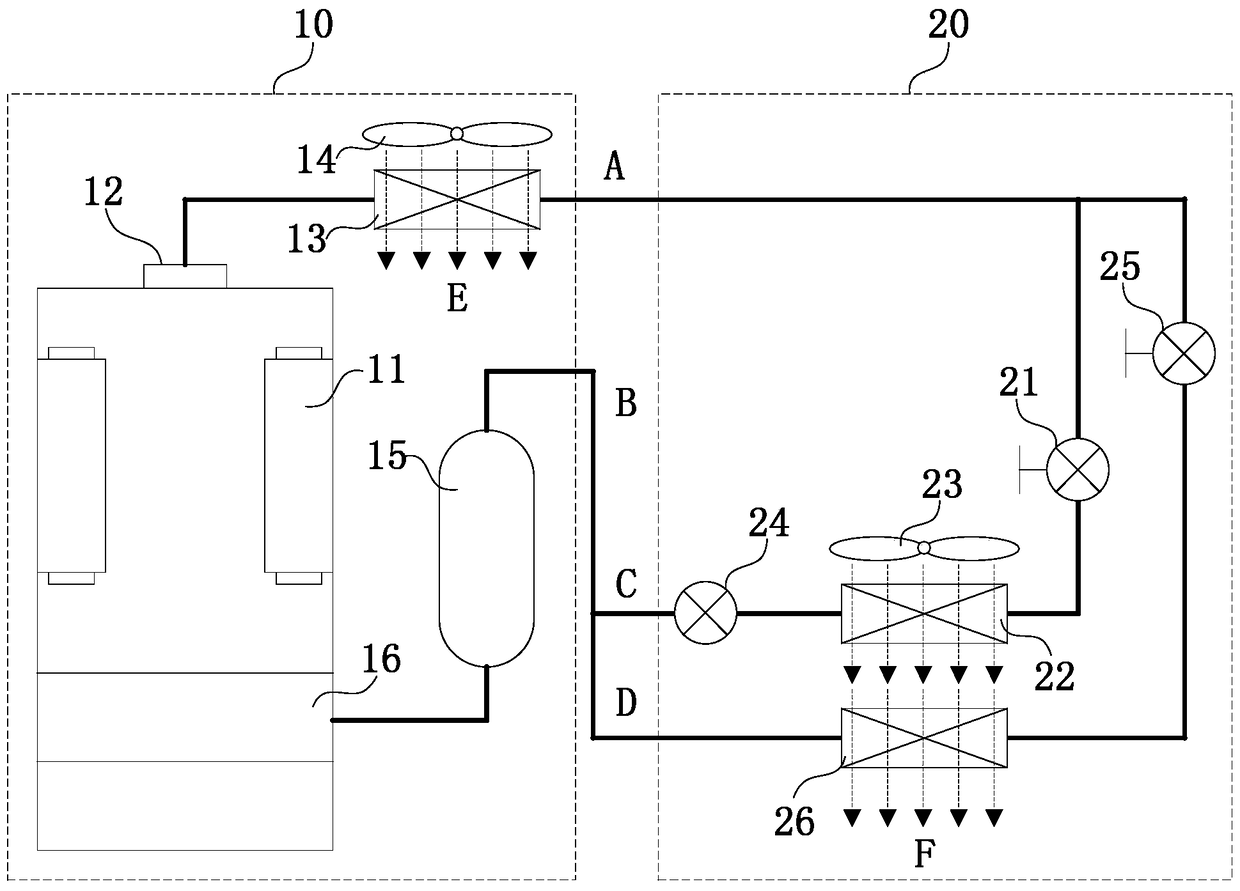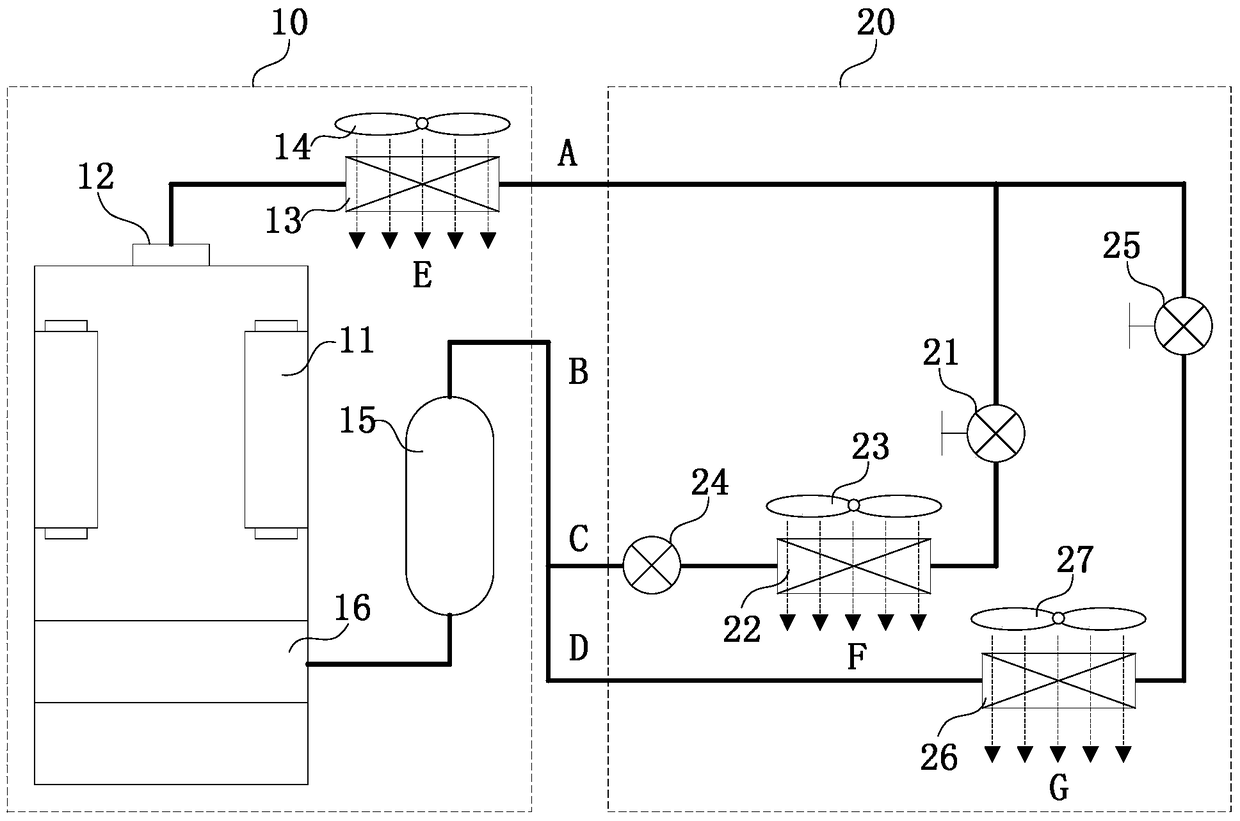an air conditioning system
An air-conditioning system and evaporator technology, which is applied to the details of space heating and ventilation, household heating, heating methods, etc., can solve problems such as uneconomical operation, increased input force, and lower evaporating temperature, and avoid mixed pulsation and output. The effect of moderate air temperature and improved comfort
- Summary
- Abstract
- Description
- Claims
- Application Information
AI Technical Summary
Problems solved by technology
Method used
Image
Examples
no. 1 example
[0047] figure 1 It is a connection schematic diagram of the air conditioning system according to the first embodiment of the present invention. Such as figure 1 As shown, an air conditioning system of the present invention includes: an outdoor unit 10 and an indoor unit 20 . Wherein, the outdoor unit 10 includes a compressor 11 , a condenser 13 , a first fan 14 and a liquid accumulator 15 . The first end of the condenser 13 is connected to the exhaust port 12 of the compressor 11 , and the second end is connected to the air inlet A of the indoor unit 20 . A first end of the accumulator 15 is connected to the liquid outlet B of the indoor unit 20 , and a second end is connected to the compression chamber 16 of the compressor 11 . The air duct E of the first fan 14 passes through the condenser 13 .
[0048] The indoor unit 20 includes a first pipeline and a second pipeline connected in parallel. The first pipeline includes a first electronic expansion valve 21, a first evapo...
specific Embodiment approach
[0052] The indoor evaporator of the present invention is divided into two parts: the first evaporator 22 is a high-temperature evaporator (mainly responsible for sensible heat load), and the second evaporator 26 is a low-temperature evaporator (mainly responsible for latent heat load). After the exhaust gas from the compressor enters the condenser 13, it is divided into two paths, each of which enters two evaporators with different evaporation temperatures, and the refrigerant flow rate entering the evaporator and the air volume of the indoor unit are adjusted through their respective electronic expansion valves to realize the first evaporator 22 and the second evaporator 26 work at two different evaporating temperatures; at the same time, a back pressure valve is set at the outlet of the evaporator (the first evaporator 22) with a higher evaporating temperature. The pressure of the refrigerant at the outlet of the low evaporator (second evaporator 26) is close; after the two r...
no. 2 example
[0056] figure 2 It is a connection schematic diagram of the air conditioning system according to the second embodiment of the present invention. Such as figure 2 As shown, another air conditioning system of the present invention is the same as the first embodiment in that the air conditioning system includes: an outdoor unit 10 and an indoor unit 20 . Wherein, the outdoor unit 10 includes a compressor 11 , a condenser 13 , a first fan 14 and a liquid accumulator 15 . The first end of the condenser 13 is connected to the exhaust port 12 of the compressor 11 , and the second end is connected to the air inlet A of the indoor unit 20 . The first end of the accumulator is connected to the liquid outlet B of the indoor unit 20 , and the second end is connected to the compression chamber 16 of the compressor 11 . The air duct E of the first fan 14 passes through the condenser 13 .
[0057] The indoor unit 20 includes a first pipeline and a second pipeline connected in parallel....
PUM
 Login to View More
Login to View More Abstract
Description
Claims
Application Information
 Login to View More
Login to View More - R&D
- Intellectual Property
- Life Sciences
- Materials
- Tech Scout
- Unparalleled Data Quality
- Higher Quality Content
- 60% Fewer Hallucinations
Browse by: Latest US Patents, China's latest patents, Technical Efficacy Thesaurus, Application Domain, Technology Topic, Popular Technical Reports.
© 2025 PatSnap. All rights reserved.Legal|Privacy policy|Modern Slavery Act Transparency Statement|Sitemap|About US| Contact US: help@patsnap.com


